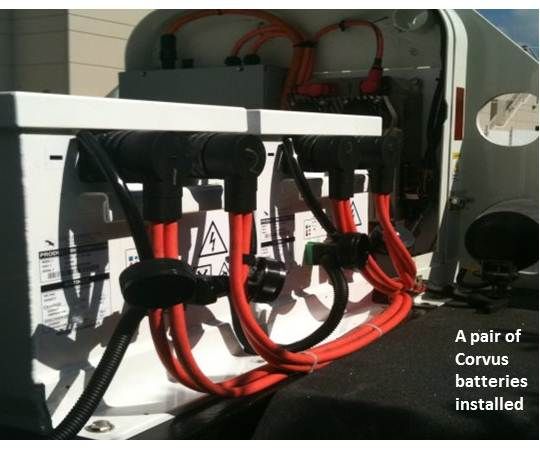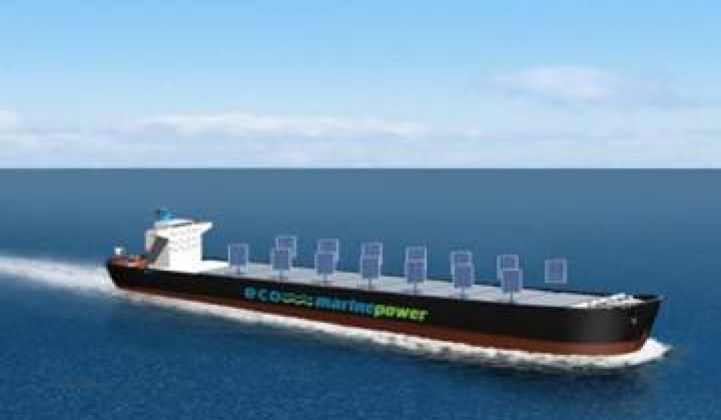Doing research into renewables, Greg Atkinson, Director for Eco Marine Power, was “struck” by Japanese engineers’ efforts during the energy crises of the 1970s to perfect rigid sails.
Because rigid sails would be ideal for ocean-going freighters with crews too small to manage canvas sails, Atkinson became intrigued with the design challenge. “You can harness the power of the wind,” Atkinson said, without incurring the expense of a big crew. “You lose something in power,” he said, “but it’s not going to cost as much.”
Solar panels are common on sailing vessels, Atkinson said, and “wind is next the logical step. If you have a wind solution, and you have this area on the sail, then you could either leave it blank or put solar panels on it.”
Wind is the focus for Aquarius, Atkinson said. “Generally, a good wind is going to beat the power that you’re going to get from solar panels, but the cost of solar modules has come down so much that you can add it.”
By catching the wind in an array of rigid sails that also capture incidental sun power, Atkinson expects Aquarius to cut trans-ocean freighters’ use of highly polluting bunker fuel by ten percent to twenty percent. “We’re not trying to develop a ship which has no main engines,” he said. “This is a fuel-saving technology. We’re not suggesting that this is going to be a wind- and solar-powered ship.”

Even combined, solar and wind cannot match the power and reliability of a freighter’s engines, Atkinson said, “but if we can get renewable energy onto a ship, and it’s saving them ten percent to twenty percent -- or who knows, even more -- in annual fuel costs in a cost-effective way, it will be an attractive technology.”
Atkinson hopes Aquarius will have a five- to seven-year return on investment (ROI). But the concept is far from complete, he acknowledged. The type of solar technology, the sail configuration and many other important details remain undetermined. His ROI calculation, therefore, is little more than wishful thinking at this juncture.
“At current bunker fuel prices,” he estimated, “annual fuel savings of between $800,000 to $1,000,000 are quite achievable for a large Capesize bulk carrier.” Most importantly, he said, “we’ve learned the lessons of the past where these systems look good on paper but when you get into the practical reality of operating them at sea, they don’t make the grade.”
When he is ready to take the completed Aquarius concept to bankers for financing, in about a year, “we hope we get the balance right between wind and solar and cost and safety.”
The addition of Corvus Energy’s lithium-polymer battery system will enhance the feasibility of Aquarius. “It provides the highest energy and power of any lithium battery made today,” said Corvus CEO Brent Perry, who first met Atkinson during a sustainable shipping awards dinner in London at which they were both nominees.
The Corvus AT6500 132-pound unit has a 6.5 kilowatt-hour storage capacity and has found wide acceptance in tugs, ferries, oil platforms and other ocean applications. Battery banks make for a “scalable and flexible” system. “Per sail,” Perry said, “we could go up to around a megawatt-hour if we needed to.”

The size of the storage system “is driven by what the purpose of the energy is and how cost-effective it ultimately is,” Perry said.
The stored energy may be used to power a freighter at sea or to power the ship for the one day it typically spends in port loading and unloading.
“The idea of the system,” Perry said, “is that there will be anywhere from eight to ten or up to twenty” sails, adding, “These are not small sails.” They could require, he said, “anywhere from 60 batteries per sail for a 400-kilowatt-hour system to 150 batteries per sail” for a larger configuration. But the cost-effectiveness of systems larger than 400 kilowatt-hours, Perry mentioned, is dubious considering today’s storage costs.
“Our power right now is about $1,100 per kilowatt-hour,” Perry said. “So we would be looking in this situation at about $440,000 per sail, assuming 60 battery modules and 400 kilowatt-hours.”
Cost-effectiveness comes, Perry explained, from the almost continuous use to which the freighters are put. “They spend a great deal of time in motion so if you can reduce the fuel consumption by twenty percent,” he said, “and you can do that for, say, 6,000 hours per year of operation, that’s a pretty effective number.”
Corvus batteries generally have a two- to five-year payback, Perry said. That gets close to the ROI Atkinson is shooting for if he can keep the cost of the rigid solar sails down.
“It has to be a robust mast and the solar sails have to be robust because you’re in a pretty harsh environment,” Perry said. “But I think the battery is the most expensive element in that system.”



